
- HOME
- Reggie Young Discography Project
- Travis Wammack
- Junior Lowe
- Clarence Nelson
- Willie Hightower Special Report
- Case Files
- red kelly index
- Soul Sauce
- YouTube Channel
- The Cosimo Code
- The B Side
- The A Side
- Soul Detective Blog
- Soul Sauce Archives
- Burning Questions
- Holy Ghost
- Contact us


This is the companion 'liner notes' page for the complete 1967 discography, which at last count featured over 450 playable tracks. Please check it out... then come on back here and join in the discussion and send us your comments via email Thanks!
The in-depth notes for this all-important year have been split into 'episodes' - just click on the links below:
EPISODE ONE: SHO IS GOOD
EPISODE TWO: WAYNE'S WORLD
EPISODE THREE: LET IT HAPPEN
EPISODE FOUR: CAN'T GET NO RIDE
EPISODE FIVE: A TOUCH OF THE BLUES
 This episode is dedicated to the memory of Sherry Emmons Brugman who, like her father, was much loved by all who knew her. Her enthusiasm and warmth of spirit shone like the sun. It was Sherry's kindness that made it possible for us to digitize Bobby's session log books, thereby insuring that his music will live on for future generations...
This episode is dedicated to the memory of Sherry Emmons Brugman who, like her father, was much loved by all who knew her. Her enthusiasm and warmth of spirit shone like the sun. It was Sherry's kindness that made it possible for us to digitize Bobby's session log books, thereby insuring that his music will live on for future generations...
May God Rest Her Beautiful Soul.
As we discussed in episode one, 1967 was a transitional year at Hi Records. Let's take a closer look at what was happening down there on South Lauderdale:
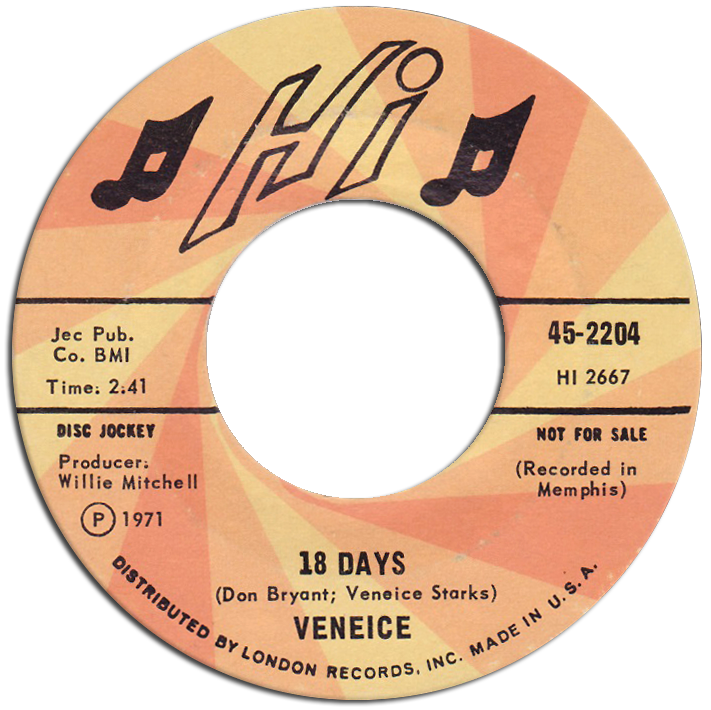 Despite being listed as the lone songwriter of the soulful The Goodest Man (the flip of Gene 'Bowlegs' Miller's only single for the label in 1967), despite her superb lip-sync performances of unreleased Hi tracks on back-to-back episodes of The!!!!Beat in 1966, the great Veniece Starks would have no 1967 releases of her own on Hi. As a matter of fact, of the four sessions held on her that year, the only track listed by name in Bobby's book to see the light of day was 18 Days, which wasn't released until 1971 (as a B side, and then again as one in 1974!), and the label couldn't even bother to spell her name correctly. This classy lady (who passed away, sadly, in 2019) deserved better (there, I've said it).
Despite being listed as the lone songwriter of the soulful The Goodest Man (the flip of Gene 'Bowlegs' Miller's only single for the label in 1967), despite her superb lip-sync performances of unreleased Hi tracks on back-to-back episodes of The!!!!Beat in 1966, the great Veniece Starks would have no 1967 releases of her own on Hi. As a matter of fact, of the four sessions held on her that year, the only track listed by name in Bobby's book to see the light of day was 18 Days, which wasn't released until 1971 (as a B side, and then again as one in 1974!), and the label couldn't even bother to spell her name correctly. This classy lady (who passed away, sadly, in 2019) deserved better (there, I've said it).
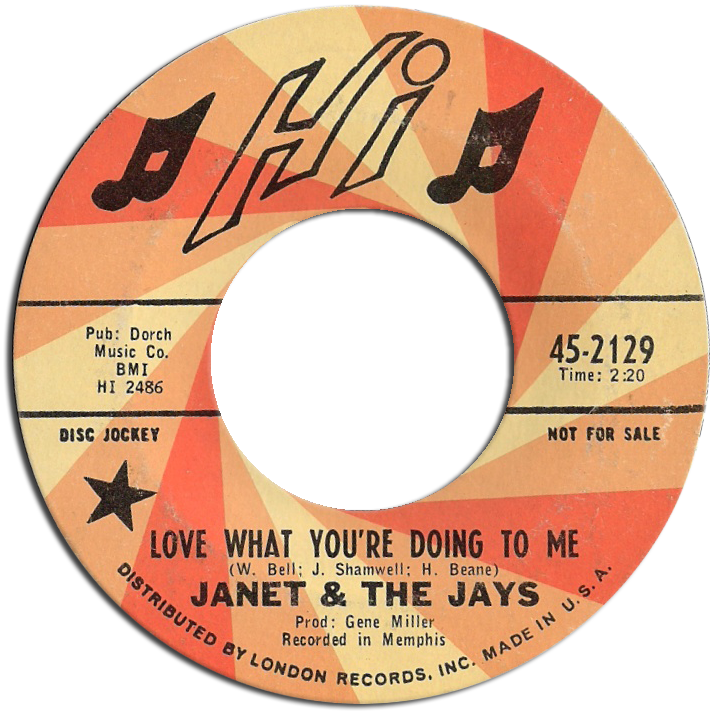
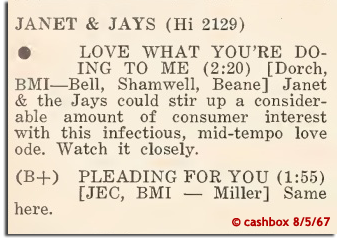 Up until this point, there was no producer credit given on Hi 45 labels, and it's interesting to note that both Bowlegs Miller and Willie Mitchell were the first to receive one on back-to-back Hi releases that Summer. Miller's production of Love What You're Doing To Me on Janet & The Jays is pure uptown Soul, kind of like Stax meets Motown. Small wonder it sounds like a Stax record, as it was written by McLemore Avenue heavyweights William Bell, Joe Shamwell and Harold Beane. Picked as a 'Best Bet' in Cashbox, apparently all bets were off as once again Hi seems to have dropped the ball on promoting another highly talented young lady (even though they managed to spell her name correctly this time out). According to Sir Shambling, the group hailed from Holly Springs, Mississippi and, in addition to Janet Wallace, included Essie Brown and Marilyn James. As far as I can tell, this would be their final release... what a shame.
Up until this point, there was no producer credit given on Hi 45 labels, and it's interesting to note that both Bowlegs Miller and Willie Mitchell were the first to receive one on back-to-back Hi releases that Summer. Miller's production of Love What You're Doing To Me on Janet & The Jays is pure uptown Soul, kind of like Stax meets Motown. Small wonder it sounds like a Stax record, as it was written by McLemore Avenue heavyweights William Bell, Joe Shamwell and Harold Beane. Picked as a 'Best Bet' in Cashbox, apparently all bets were off as once again Hi seems to have dropped the ball on promoting another highly talented young lady (even though they managed to spell her name correctly this time out). According to Sir Shambling, the group hailed from Holly Springs, Mississippi and, in addition to Janet Wallace, included Essie Brown and Marilyn James. As far as I can tell, this would be their final release... what a shame.
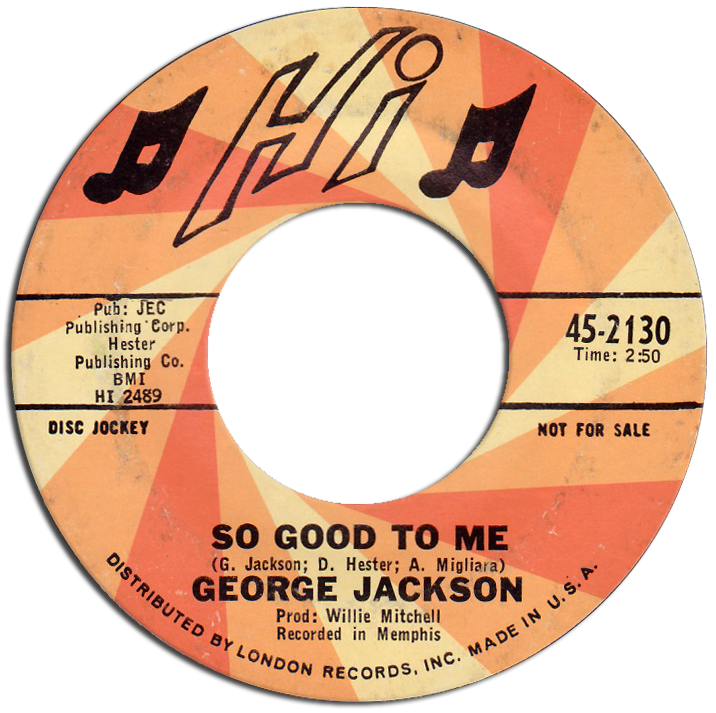
 It was the next Hi 45, however, that was the first to credit Willie Mitchell as producer. It was the A side of that record that was predicted by Billboard to make the R&B charts (although it didn't), and was a song so good that Hi would issue it again in 1972, but let's focus on this hidden gem of a B side. George Jackson had been working with Quinton Claunch and Dan Greer at Goldwax, where they had had a 1966 single release as George and Greer which went nowhere. Alex Migliara was a Memphis music industry attorney and agent, who had been writing liner notes for Hi LPs on Ace Cannon and Willie Mitchell. I imagine it was Migliara who brought George to Willie at Hi, even though he may have still been under contract to Goldwax (more on that in episode six). In any event, Migliara helped himself to a share of the writer's credit on both sides (along with another Goldwax mainstay, Dot Hester) on this August release. So Good To Me just cooks along, once again mining some of that Motown magic, with Tommy Cogbill just going off on bass. What a record!
It was the next Hi 45, however, that was the first to credit Willie Mitchell as producer. It was the A side of that record that was predicted by Billboard to make the R&B charts (although it didn't), and was a song so good that Hi would issue it again in 1972, but let's focus on this hidden gem of a B side. George Jackson had been working with Quinton Claunch and Dan Greer at Goldwax, where they had had a 1966 single release as George and Greer which went nowhere. Alex Migliara was a Memphis music industry attorney and agent, who had been writing liner notes for Hi LPs on Ace Cannon and Willie Mitchell. I imagine it was Migliara who brought George to Willie at Hi, even though he may have still been under contract to Goldwax (more on that in episode six). In any event, Migliara helped himself to a share of the writer's credit on both sides (along with another Goldwax mainstay, Dot Hester) on this August release. So Good To Me just cooks along, once again mining some of that Motown magic, with Tommy Cogbill just going off on bass. What a record!
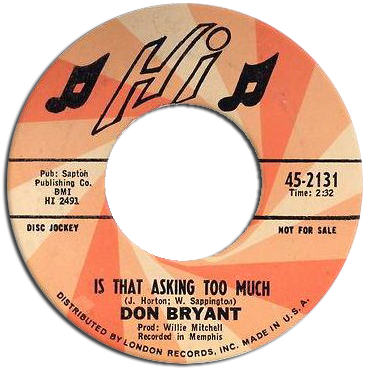
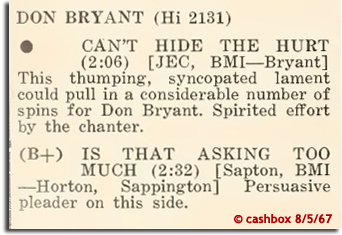 There were two sessions held on Don Bryant in January, but Hi chose to use a track recorded six months earlier, The Call Of Distress, as the flip of his first single release from those sessions that April (maybe because Ray Harris claimed half the songwriting credit?). In episode one we already mentioned the top side of Don's next Hi 45, identified by Reggie as being cut on January 6th, but not released until July. Check out the equally great B side of that record (given a B+ by Cashbox), Is That Asking Too Much. Probably cut at the June 30th session (with Willie Mitchell listed as the producer), I'm thinking it features both Teenie Hodges and Reggie on guitar. As Don recently told Heikki Suasolo, "It was not all the time I was trying to sound like somebody else. I was trying to get ideas from what was going on at the time and, depending on the type of song, I would model it on somebody." Judging by those killer unreleased Detroit demos (that we talked about in episode one), they were often better than whomever it was he was modeling them on! Bryant had one more 45 issued by Hi that October, but by then both Reggie and Bobby Emmons had pretty much flown the coop. [If you haven't already, you should buy Bryant's Grammy nominated 2020 album You Make Me Feel. I swear, the man is singing better now than he was back then! You go, Don!]
There were two sessions held on Don Bryant in January, but Hi chose to use a track recorded six months earlier, The Call Of Distress, as the flip of his first single release from those sessions that April (maybe because Ray Harris claimed half the songwriting credit?). In episode one we already mentioned the top side of Don's next Hi 45, identified by Reggie as being cut on January 6th, but not released until July. Check out the equally great B side of that record (given a B+ by Cashbox), Is That Asking Too Much. Probably cut at the June 30th session (with Willie Mitchell listed as the producer), I'm thinking it features both Teenie Hodges and Reggie on guitar. As Don recently told Heikki Suasolo, "It was not all the time I was trying to sound like somebody else. I was trying to get ideas from what was going on at the time and, depending on the type of song, I would model it on somebody." Judging by those killer unreleased Detroit demos (that we talked about in episode one), they were often better than whomever it was he was modeling them on! Bryant had one more 45 issued by Hi that October, but by then both Reggie and Bobby Emmons had pretty much flown the coop. [If you haven't already, you should buy Bryant's Grammy nominated 2020 album You Make Me Feel. I swear, the man is singing better now than he was back then! You go, Don!]
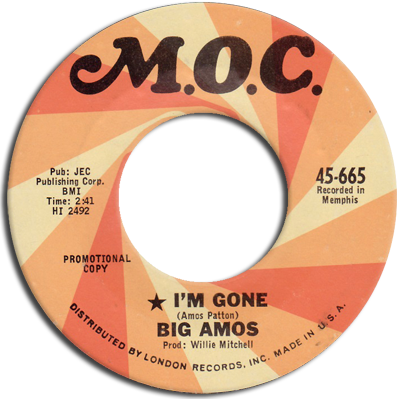
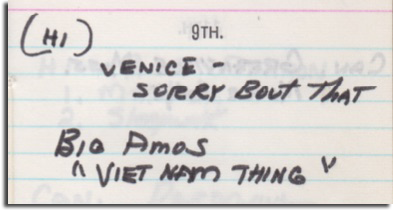 Hi subsidiary label M.O.C. would issue only three singles in 1967. The first one, an awesome record by Norm West (with both sides penned by Don Bryant) was issued in May, but had been cut at a session back in February of 1966. The next release would be by the way cool Big Amos. Although both books list a split session held on him on February 9th, they only mention the flip side, Going To Vietnam (and yet another unreleased Veniece track). The big fat Willie Mitchell production here on the plug side, I'm Gone, may have been cut at an earlier session in November, as I'd say that's definitely Reggie on guitar and Bobby on the organ. In any event, it's another little known slice of the emerging 'Sound of Memphis'. Except for a couple more songs trotted out of the can in 1970 for Hi Lp Rivertown Blues, Big Amos Patton's career ended, unfortunately, here.
Hi subsidiary label M.O.C. would issue only three singles in 1967. The first one, an awesome record by Norm West (with both sides penned by Don Bryant) was issued in May, but had been cut at a session back in February of 1966. The next release would be by the way cool Big Amos. Although both books list a split session held on him on February 9th, they only mention the flip side, Going To Vietnam (and yet another unreleased Veniece track). The big fat Willie Mitchell production here on the plug side, I'm Gone, may have been cut at an earlier session in November, as I'd say that's definitely Reggie on guitar and Bobby on the organ. In any event, it's another little known slice of the emerging 'Sound of Memphis'. Except for a couple more songs trotted out of the can in 1970 for Hi Lp Rivertown Blues, Big Amos Patton's career ended, unfortunately, here.
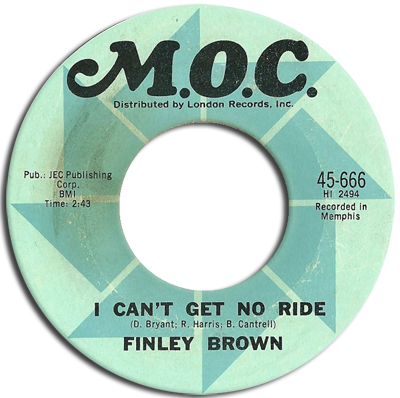
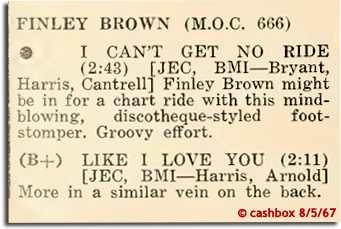 The final 1967 M.O.C. 45 was cut during two separate sessions held on a local kid named Finley Brown in May and June. Just a wild record, I Can't Get No Ride (with both Bill Cantrell and Ray Harris sharing the songwriting credits with Don Bryant) kinda sounds like Sam The Sham meets The Hombres (or something). Billed as a 'mind-blowing... groovy effort' in the same August 5th edition of Cashbox mentioned earlier, Hi was no doubt looking to grab a piece of that psychedelic Summer of Love thang. The predicted 'chart ride' never happened though, and Finley would go on to cut a couple of singles for Stax subsidiary Enterprise before fading from view.
The final 1967 M.O.C. 45 was cut during two separate sessions held on a local kid named Finley Brown in May and June. Just a wild record, I Can't Get No Ride (with both Bill Cantrell and Ray Harris sharing the songwriting credits with Don Bryant) kinda sounds like Sam The Sham meets The Hombres (or something). Billed as a 'mind-blowing... groovy effort' in the same August 5th edition of Cashbox mentioned earlier, Hi was no doubt looking to grab a piece of that psychedelic Summer of Love thang. The predicted 'chart ride' never happened though, and Finley would go on to cut a couple of singles for Stax subsidiary Enterprise before fading from view.
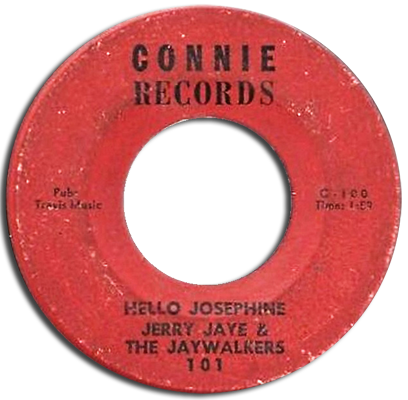 Jerry Jaye & The Jaywalkers were a Rockabilly outfit that had been out there working the Arkansas club circuit since the late fifties. After a couple of releases on local labels that withered away, they came to Roland Janes at Sonic and cut two sides in the Fall of 1966. Jaye then created his own label, Connie, and pressed up 500 copies of the record to sell at the band's gigs. He then brought a box of 25 of them to Joe Cuoghi at Poplar Records, who used his considerable clout to get the B side chosen as 'pick of the week' at Memphis radio station WCM, after which the initial run sold out in a flash. Cuoghi (and Ray Harris) offered Jerry a deal...
Jerry Jaye & The Jaywalkers were a Rockabilly outfit that had been out there working the Arkansas club circuit since the late fifties. After a couple of releases on local labels that withered away, they came to Roland Janes at Sonic and cut two sides in the Fall of 1966. Jaye then created his own label, Connie, and pressed up 500 copies of the record to sell at the band's gigs. He then brought a box of 25 of them to Joe Cuoghi at Poplar Records, who used his considerable clout to get the B side chosen as 'pick of the week' at Memphis radio station WCM, after which the initial run sold out in a flash. Cuoghi (and Ray Harris) offered Jerry a deal...

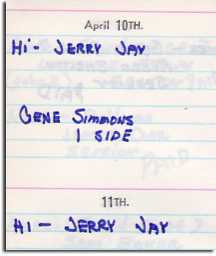 Hi would re-issue the 45 (this time with the correct title and songwriting credits), and sign Jaye as an artist for future releases. With London's distribution behind it, My Girl Josephine would spend nine weeks on the Hot 100, climbing as high as #29. Hi Records hadn't dented the charts since Willie Mitchell's Bad Eye in 1966, and the pressure was on to cut an LP while the record was hot. According to Jerry, "We cut the album in one day. We started around two in the afternoon, took a break around ten and went for a bite to eat, came back and by four the next morning we had the album cut. It was really rushed."
Hi would re-issue the 45 (this time with the correct title and songwriting credits), and sign Jaye as an artist for future releases. With London's distribution behind it, My Girl Josephine would spend nine weeks on the Hot 100, climbing as high as #29. Hi Records hadn't dented the charts since Willie Mitchell's Bad Eye in 1966, and the pressure was on to cut an LP while the record was hot. According to Jerry, "We cut the album in one day. We started around two in the afternoon, took a break around ten and went for a bite to eat, came back and by four the next morning we had the album cut. It was really rushed."
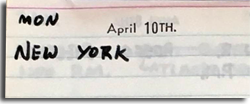 According to Bobby's session notes, that would have been on April 10th and 11th, despite the fact that Jerry Wexler had flown Reggie, Tommy Cogbill (and like half of Muscle Shoals) up to New York on the 10th. Predictably, Jaye's album (which lists Cuoghi himself as the producer) just isn't that good. The follow-up single, another cover of a Fats Domino tune pulled from the Lp, fell on deaf ears, as did four more Hi releases on him. I think it says a lot about the state of affairs on South Lauderdale at this point that the only real chart hit that Hi would have in 1967 was cut at Sonic...
According to Bobby's session notes, that would have been on April 10th and 11th, despite the fact that Jerry Wexler had flown Reggie, Tommy Cogbill (and like half of Muscle Shoals) up to New York on the 10th. Predictably, Jaye's album (which lists Cuoghi himself as the producer) just isn't that good. The follow-up single, another cover of a Fats Domino tune pulled from the Lp, fell on deaf ears, as did four more Hi releases on him. I think it says a lot about the state of affairs on South Lauderdale at this point that the only real chart hit that Hi would have in 1967 was cut at Sonic...
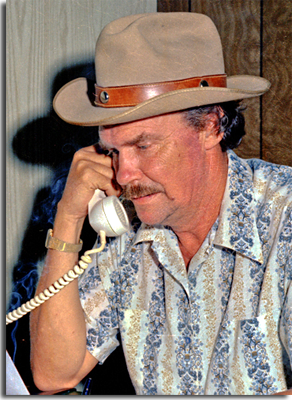 According to Reggie, he had gotten a phone call from Ray Harris somewhere right around in here that had changed everything. "Listen, I know we've been paying you guys fifteen dollars a session," Harris told him, "but we're gonna have to cut it to ten..." Within a few hours, Young said, he got a call from Joe Cuoghi telling him to disregard what Ray said, assuring him that things would continue on as usual, but the damage had already been done. From that moment on, Reggie told me, he had made up his mind that it was time to move on.
According to Reggie, he had gotten a phone call from Ray Harris somewhere right around in here that had changed everything. "Listen, I know we've been paying you guys fifteen dollars a session," Harris told him, "but we're gonna have to cut it to ten..." Within a few hours, Young said, he got a call from Joe Cuoghi telling him to disregard what Ray said, assuring him that things would continue on as usual, but the damage had already been done. From that moment on, Reggie told me, he had made up his mind that it was time to move on.
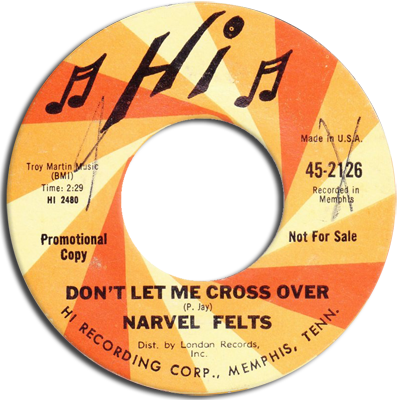 If Hi as a company at this point seemed a bit behind the times when it came to Soul or Rock & Roll, when it came to Country they were a bit ahead of them - with the same results. Narvel Felts had first recorded on South Lauderdale in 1959 with Cowboy Jack Clement, and had been signed by Roland Janes at Sonic shortly after that. With over a dozen releases as a Pop artist that failed to click with the public, Hi signed him in 1966. After two more lackluster singles, somebody at the label (probably Ray Harris) decided to 'cut him Country' on Carl Butler's 1962 smash hit, Don't Let Me Cross Over. Nobody bought it. When Jerry Kennedy cut the same song on Jerry Lee and Linda Gail Lewis two years later, it went top ten Country. Go figure. Ironically, Narvel would break into that same top ten himself in 1973 with a cover of Dobie Gray's (and Reggie's) masterpiece Drift Away, the first of over forty chart entries in the decade to follow.
If Hi as a company at this point seemed a bit behind the times when it came to Soul or Rock & Roll, when it came to Country they were a bit ahead of them - with the same results. Narvel Felts had first recorded on South Lauderdale in 1959 with Cowboy Jack Clement, and had been signed by Roland Janes at Sonic shortly after that. With over a dozen releases as a Pop artist that failed to click with the public, Hi signed him in 1966. After two more lackluster singles, somebody at the label (probably Ray Harris) decided to 'cut him Country' on Carl Butler's 1962 smash hit, Don't Let Me Cross Over. Nobody bought it. When Jerry Kennedy cut the same song on Jerry Lee and Linda Gail Lewis two years later, it went top ten Country. Go figure. Ironically, Narvel would break into that same top ten himself in 1973 with a cover of Dobie Gray's (and Reggie's) masterpiece Drift Away, the first of over forty chart entries in the decade to follow.
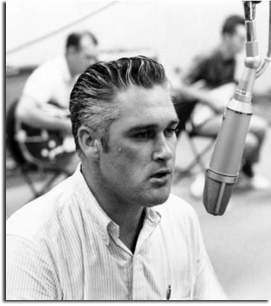 In late 1966, Hi had signed Charlie Rich with the stipulation that his manager, Seymour Rosenberg (yes, the same guy who had been a partner with Chips at American), could produce him. After one lavish release that didn't sell, 'Sy Rose' was back at it in February, recording Rich on a slew of demos that would go unreleased, including some of the same tracks that Willie Mitchell had cut on the folks from Detroit (see episode one). According to Colin Escott's liner notes for I'll Shed No Tears, it was Ray Harris and Joe Cuoghi who "came up with the concept of a Hank Williams tribute album recorded in an uptown Country style."
In late 1966, Hi had signed Charlie Rich with the stipulation that his manager, Seymour Rosenberg (yes, the same guy who had been a partner with Chips at American), could produce him. After one lavish release that didn't sell, 'Sy Rose' was back at it in February, recording Rich on a slew of demos that would go unreleased, including some of the same tracks that Willie Mitchell had cut on the folks from Detroit (see episode one). According to Colin Escott's liner notes for I'll Shed No Tears, it was Ray Harris and Joe Cuoghi who "came up with the concept of a Hank Williams tribute album recorded in an uptown Country style."
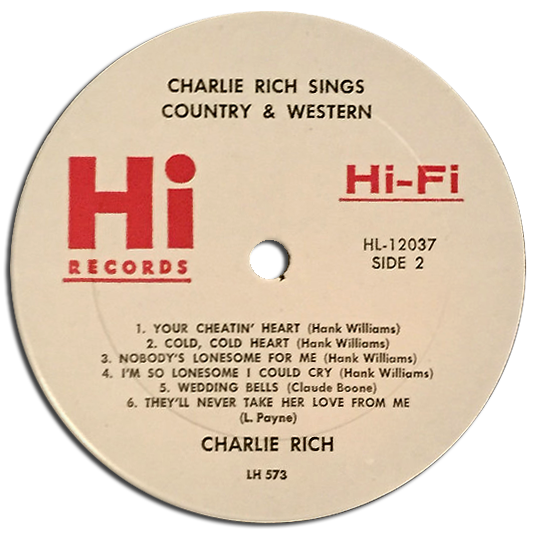 On the surface, it seemed like a great idea, only once the tracks for the record were completed in March, Hank's widow supposedly objected to Hi using his name on the album... although the real story is probably that she wanted Hi to fork over some cash to use it, and that wasn't gonna happen. "It was just a shot," Ray Harris told Hank Davis, "we were trying to be successful for Charlie. You never know in the record business." No, you sure don't. Released in May as Charlie Rich Sings Country & Western, it didn't sell, nor did the single culled from the album. Although a lot of it is a little too 'syrupy' for my taste, the great head arrangement here on Cold, Cold Heart (despite the cloying background vocals) still holds up, I think.
On the surface, it seemed like a great idea, only once the tracks for the record were completed in March, Hank's widow supposedly objected to Hi using his name on the album... although the real story is probably that she wanted Hi to fork over some cash to use it, and that wasn't gonna happen. "It was just a shot," Ray Harris told Hank Davis, "we were trying to be successful for Charlie. You never know in the record business." No, you sure don't. Released in May as Charlie Rich Sings Country & Western, it didn't sell, nor did the single culled from the album. Although a lot of it is a little too 'syrupy' for my taste, the great head arrangement here on Cold, Cold Heart (despite the cloying background vocals) still holds up, I think.

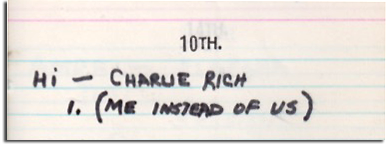 Finally given the green light to record his own compositions, Rich was back at the studio in July to cut what would become his final Hi release that Fall. This great 'undubbed' version of the top side of that single (sans background singers), Only Me, kind of foreshadows the work Reggie and Bobby would be doing with Elvis in a year or so. Once again, though, nobody seemed to notice, and when Charlie's one year contract was up, Rosenberg brought him to Billy Sherill in Nashville where he would begin his incredible onslaught of Country chart hits within a few months, and become recognized as the superstar he was. I'm sure Ray Harris and Joe Cuoghi were left shaking their heads.
Finally given the green light to record his own compositions, Rich was back at the studio in July to cut what would become his final Hi release that Fall. This great 'undubbed' version of the top side of that single (sans background singers), Only Me, kind of foreshadows the work Reggie and Bobby would be doing with Elvis in a year or so. Once again, though, nobody seemed to notice, and when Charlie's one year contract was up, Rosenberg brought him to Billy Sherill in Nashville where he would begin his incredible onslaught of Country chart hits within a few months, and become recognized as the superstar he was. I'm sure Ray Harris and Joe Cuoghi were left shaking their heads.
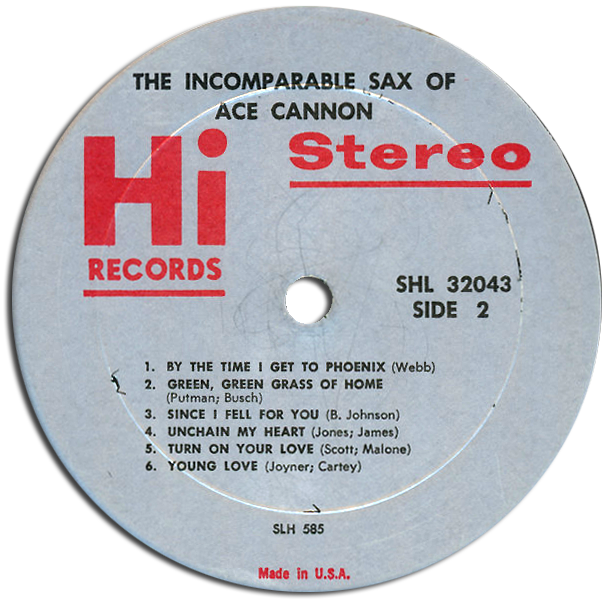
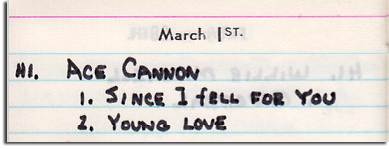 Instrumental albums had been Hi's bread and butter for years (people used to think that 'Hi' stood for 'Home of the Instrumentals'), and it was Ace Cannon who told us that Joe Cuoghi liked that "middle-of-the-road, Sinatra stuff." According to BSN Pubs, Hi would issue three albums on Ace in 1967. Bobby Emmons, in addition to performing on over fifteen live gigs with Cannon, also lists six sessions on him at Hi in his log book. Reggie, on the other hand, only noted two. This may possibly be due to the aforementioned gaps in his log entries, but one session they both made note of was on March 1st, when Since I Fell For You was recorded. Released as an album track on The Incomparable Sax Of Ace Cannon, it's another obscure 'head arrangement' of a great song that's gone unnoticed all these years.
Instrumental albums had been Hi's bread and butter for years (people used to think that 'Hi' stood for 'Home of the Instrumentals'), and it was Ace Cannon who told us that Joe Cuoghi liked that "middle-of-the-road, Sinatra stuff." According to BSN Pubs, Hi would issue three albums on Ace in 1967. Bobby Emmons, in addition to performing on over fifteen live gigs with Cannon, also lists six sessions on him at Hi in his log book. Reggie, on the other hand, only noted two. This may possibly be due to the aforementioned gaps in his log entries, but one session they both made note of was on March 1st, when Since I Fell For You was recorded. Released as an album track on The Incomparable Sax Of Ace Cannon, it's another obscure 'head arrangement' of a great song that's gone unnoticed all these years.
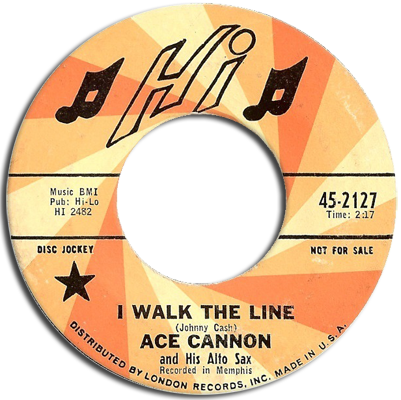 Ace Cannon would only have two single releases in '67. The first of those, issued in July, was his unique take on Johnny Cash's I Walk The Line, which later appeared on his Hi Lp Memphis Golden Hits. I hadn't realized it until I started writing this episode, but that's CLARENCE NELSON on guitar! How do I know? Well, the first clue is that Clarence always recorded with his guitar plugged straight into the board, which sounds right in this case. Secondly, it was no doubt one of eleven sides cut on Ace during sessions which Bobby (but not Reggie) had listed as being held on April 17th and 19th. It is our considered opinion that Clarence was also in the house for the April 18th session... but more on that next episode. Very Cool!
Ace Cannon would only have two single releases in '67. The first of those, issued in July, was his unique take on Johnny Cash's I Walk The Line, which later appeared on his Hi Lp Memphis Golden Hits. I hadn't realized it until I started writing this episode, but that's CLARENCE NELSON on guitar! How do I know? Well, the first clue is that Clarence always recorded with his guitar plugged straight into the board, which sounds right in this case. Secondly, it was no doubt one of eleven sides cut on Ace during sessions which Bobby (but not Reggie) had listed as being held on April 17th and 19th. It is our considered opinion that Clarence was also in the house for the April 18th session... but more on that next episode. Very Cool!
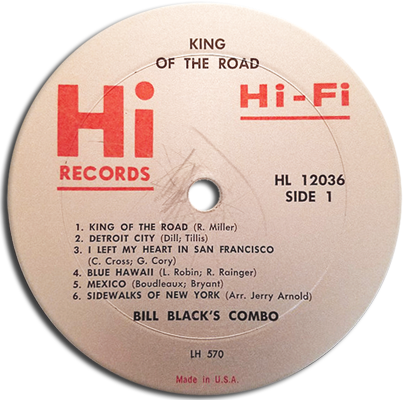
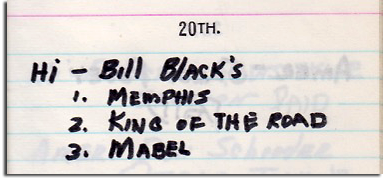 The backbone of the label, of course, had always been Bill Black's Combo, who had started the instrumental ball rolling back in 1959. Hi would release four albums on them in 1967, none of which sold very much. Bobby Emmons lists nine Bill Black sessions in his log book, Reggie only one, held on March 20th. The title track from their second release, King Of The Road, was recorded that day, and is one of the few tunes that we know for sure featured both Bobby and Reggie. Produced by Joe Cuoghi, it comes across, in my opinion, as a hackneyed holdover from a formula which had run its course by then. Black had been dead for two years, and I'm sure that by this point Young was all too ready to lay down his pencil and hit the road himself...
The backbone of the label, of course, had always been Bill Black's Combo, who had started the instrumental ball rolling back in 1959. Hi would release four albums on them in 1967, none of which sold very much. Bobby Emmons lists nine Bill Black sessions in his log book, Reggie only one, held on March 20th. The title track from their second release, King Of The Road, was recorded that day, and is one of the few tunes that we know for sure featured both Bobby and Reggie. Produced by Joe Cuoghi, it comes across, in my opinion, as a hackneyed holdover from a formula which had run its course by then. Black had been dead for two years, and I'm sure that by this point Young was all too ready to lay down his pencil and hit the road himself...
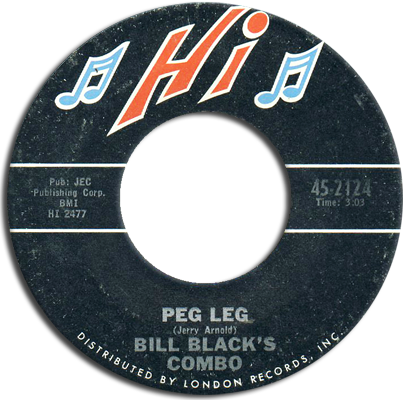
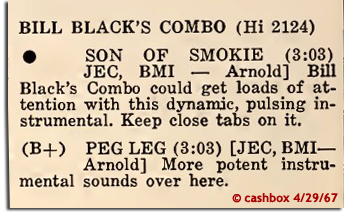 Amazingly, there would only be one single released by Bill Black's Combo in 1967, neither side of which appeared on any of the albums. As we've discussed in the past, when we asked Jerry 'Satch' Arnold why he hadn't left Hi for American when pretty much everyone else did, he answered "I wasn't asked." As the only founding member of the Combo left there on South Lauderdale, he may have felt it incumbent upon himself to carry on in Bill's name. Both sides of the single had been written (and I imagine, produced) by Arnold, which was chosen as a 'Best Bet' in Cashbox in April. The plodding B side, Peg Leg features a guitar player that is (once again) neither Reggie Young nor Clarence Nelson. Theories abound about who it might be - from Teenie Hodges to Tommy Cogbill to Chips Moman himself! Detectives?
Amazingly, there would only be one single released by Bill Black's Combo in 1967, neither side of which appeared on any of the albums. As we've discussed in the past, when we asked Jerry 'Satch' Arnold why he hadn't left Hi for American when pretty much everyone else did, he answered "I wasn't asked." As the only founding member of the Combo left there on South Lauderdale, he may have felt it incumbent upon himself to carry on in Bill's name. Both sides of the single had been written (and I imagine, produced) by Arnold, which was chosen as a 'Best Bet' in Cashbox in April. The plodding B side, Peg Leg features a guitar player that is (once again) neither Reggie Young nor Clarence Nelson. Theories abound about who it might be - from Teenie Hodges to Tommy Cogbill to Chips Moman himself! Detectives?
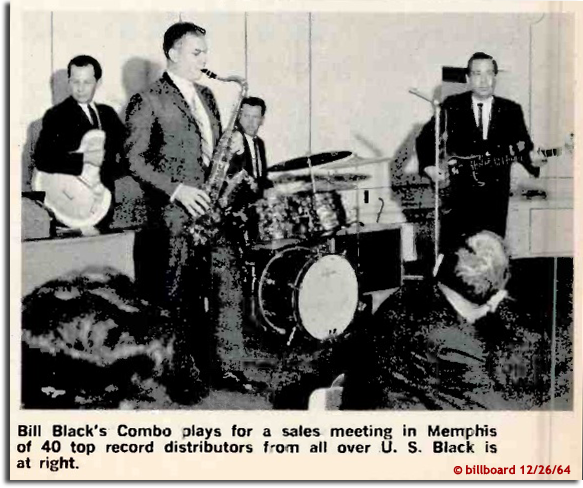
Check out this cool photo recently unearthed by Mark Nicholson in a 1964 Billboard. Tommy Cogbill is on guitar here as the picture was taken on a promotional River Boat cruise to celebrate Hi Records' fifth anniversary on September 23, 1964, when Reggie was still touring the UK with Bob Tucker and the road version of The Combo. That's Satch on drums, and Bill himself on electric bass. The gentleman on sax is Charlie Chalmers, who was about to play a significant part in the label's history.
Even though, for the most part, it was the same studio crew playing on all of Hi's instrumental releases, Willie Mitchell was the only one who had broken out of the nether regions of the Billboard charts since Cannon's Tuff in 1961. Three Willie Mitchell 45s would be issued in 1967, with Slippin' & Slidin' crawling to #96 that Summer, but let's take a look at the B sides of those three records, shall we?
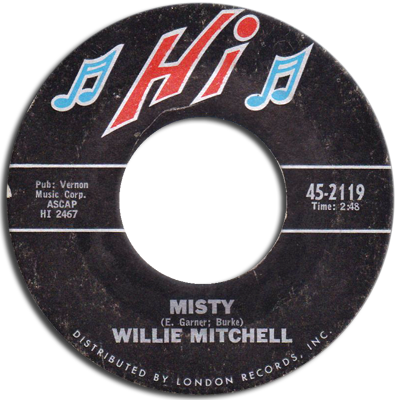
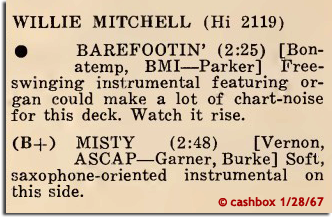 Cut in late '66, the top side of this one was another Cashbox Bet that didn't pay off, but it's the stunning B+ B side that highlights one of the most unsung of all Memphis musicians, saxophonist Fred Ford, whose elegant rendition of Erroll Garner's Misty just knocks me out. It would later be included on Hi Lp The Hit Sound Of Willie Mitchell, where Elton Whisenhunt proclaims "Fred Ford... does a terrific job. His fullness of sound, as he weaves back and forth between melody and original styling, is something to behold." It sure is. What an awesome record!
Cut in late '66, the top side of this one was another Cashbox Bet that didn't pay off, but it's the stunning B+ B side that highlights one of the most unsung of all Memphis musicians, saxophonist Fred Ford, whose elegant rendition of Erroll Garner's Misty just knocks me out. It would later be included on Hi Lp The Hit Sound Of Willie Mitchell, where Elton Whisenhunt proclaims "Fred Ford... does a terrific job. His fullness of sound, as he weaves back and forth between melody and original styling, is something to behold." It sure is. What an awesome record!
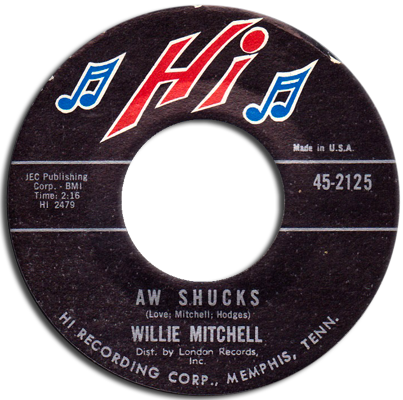
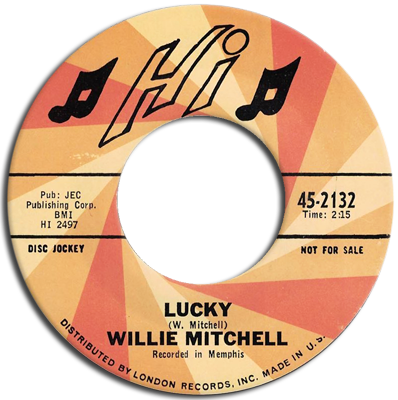 As discussed, Willie had begun bringing Teenie Hodges to the studio in 1966. Aw Shucks, the flip of the #96 'hit' mentioned earlier credits Andrew Love and Teenie as songwriters (along with Willie), and that's definitely him on guitar. On the B side of Mitchell's next release Lucky, though, I'd say that's definitely Reggie. Such was the nature of things on South Lauderdale at the time I imagine, as Reggie wasn't always around. Bobby Emmons is just killing it on both of'em, though! Neither of these sides would be included on Lp.
As discussed, Willie had begun bringing Teenie Hodges to the studio in 1966. Aw Shucks, the flip of the #96 'hit' mentioned earlier credits Andrew Love and Teenie as songwriters (along with Willie), and that's definitely him on guitar. On the B side of Mitchell's next release Lucky, though, I'd say that's definitely Reggie. Such was the nature of things on South Lauderdale at the time I imagine, as Reggie wasn't always around. Bobby Emmons is just killing it on both of'em, though! Neither of these sides would be included on Lp.
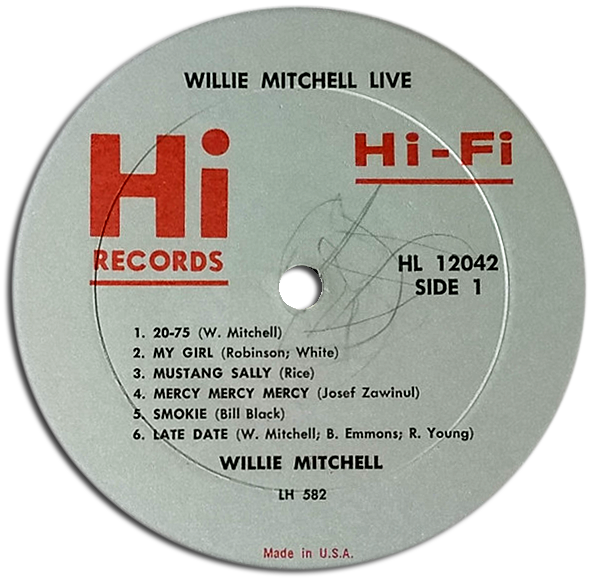
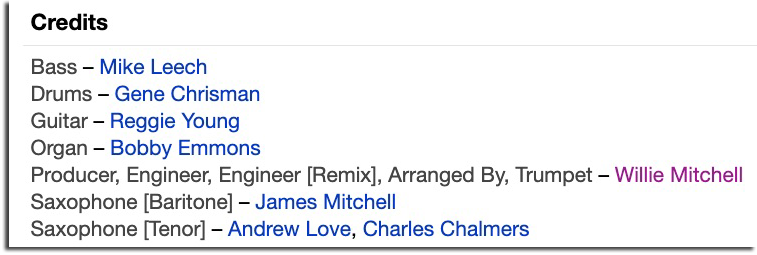 Mitchell had released two albums already but, that November, with Joe Tex's Skinny Legs And All dominating the charts with that 'live from the studio' sound, and Buddy Killen working on Tex's Live And Lively Lp in Nashville, Hi decided to cut one on Willie. When I first saw the personnel listed in the credits on Discogs, I figured they had to be wrong. By then Reggie, Bobby and Mike Leech were with Chips at American full time, I thought, and there was no way the drummer at Hi could have been Gene Chrisman... so I ran it by Charlie Chalmers, who told me "Yup. that sounds about right!" So there ya go. So much for Moman having everybody tied up at 827 Thomas, I guess! I find that whole 'live' concept kind of annoying, but check out Chalmers (who, of course, had cut the Wilson Pickett version with Chips at Fame) deep in the pocket with them Memphis Boys on Mustang Sally. Yeah, baby!
Mitchell had released two albums already but, that November, with Joe Tex's Skinny Legs And All dominating the charts with that 'live from the studio' sound, and Buddy Killen working on Tex's Live And Lively Lp in Nashville, Hi decided to cut one on Willie. When I first saw the personnel listed in the credits on Discogs, I figured they had to be wrong. By then Reggie, Bobby and Mike Leech were with Chips at American full time, I thought, and there was no way the drummer at Hi could have been Gene Chrisman... so I ran it by Charlie Chalmers, who told me "Yup. that sounds about right!" So there ya go. So much for Moman having everybody tied up at 827 Thomas, I guess! I find that whole 'live' concept kind of annoying, but check out Chalmers (who, of course, had cut the Wilson Pickett version with Chips at Fame) deep in the pocket with them Memphis Boys on Mustang Sally. Yeah, baby!
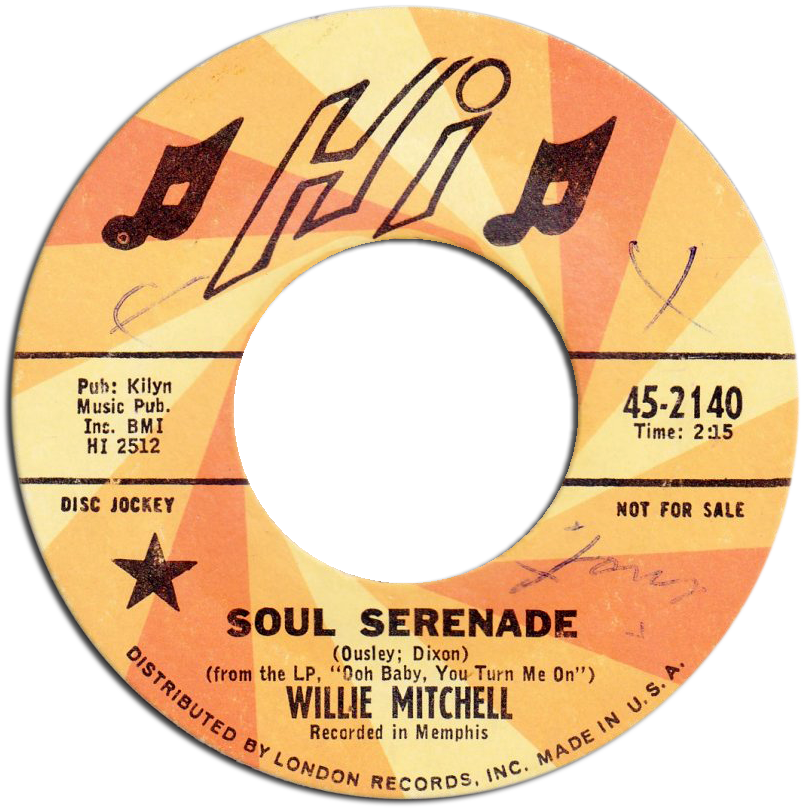
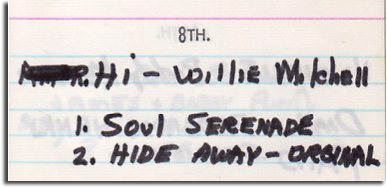 In early 1968, when Hi traditionally would have released a single from the album, they put Willie's 'live' cover of Joe Zawinul's Mercy, Mercy, Mercy out as the B side, but chose a track from the previous Lp, Ooh Baby, You Turn Me On, as the plug side. Cut back on March 8th, Soul Serenade features Teenie Hodges' guitar front and center, with the role of King Curtis being played brilliantly by Charlie Chalmers. The record took off, soaring into the top ten on the R&B charts, and even climbing as high as #23 on the Hot 100. In many ways, the success of this 45 paved the way for the future at Hi Records in the post-Reggie (and Bobby) era as, within a year, the rest of the Hodges brothers would join with Teenie and Howard Grimes to form Hi Rhythm and, shortly after that, Charlie would lay down his horn to anchor the distinctive background vocals of Rhodes-Chalmers-Rhodes on dozens of Hi hits to come...
In early 1968, when Hi traditionally would have released a single from the album, they put Willie's 'live' cover of Joe Zawinul's Mercy, Mercy, Mercy out as the B side, but chose a track from the previous Lp, Ooh Baby, You Turn Me On, as the plug side. Cut back on March 8th, Soul Serenade features Teenie Hodges' guitar front and center, with the role of King Curtis being played brilliantly by Charlie Chalmers. The record took off, soaring into the top ten on the R&B charts, and even climbing as high as #23 on the Hot 100. In many ways, the success of this 45 paved the way for the future at Hi Records in the post-Reggie (and Bobby) era as, within a year, the rest of the Hodges brothers would join with Teenie and Howard Grimes to form Hi Rhythm and, shortly after that, Charlie would lay down his horn to anchor the distinctive background vocals of Rhodes-Chalmers-Rhodes on dozens of Hi hits to come...
- red kelly, September 2021
Special thanks go to Howard Grimes, Charlie Chalmers, Ace Cannon, Jerry 'Satch' Arnold, Don Bryant, Scott Bomar, Colin Escott, Hank Davis, John Ridley, Tom DeJong, Mark Nicholson and John Broven.
We continue our discussion of the incredible body of work that Reggie Young and Bobby Emmons created together in 1967 in episode five, just click on the link below. It's also over on Soul Sauce... but don't forget the other 450 or so tracks that are always available on our discography page! Thanks for tuning in!
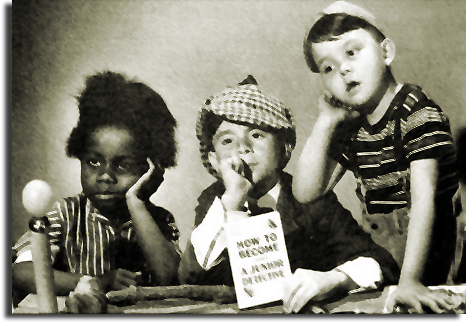


Hey y'all - after being holed up here in the Soul Cellar for about eight weeks during these troubled times, I've decided to try and reinvent the Burning Questions concept and attempt to bring it to a wider audience. The first thing I did was create a (gasp!) Soul Detective Facebook Page where we will work on answering these questions together in the time-honored Soul Detective tradition. Y'all ready?
This one's been bugging me for years...
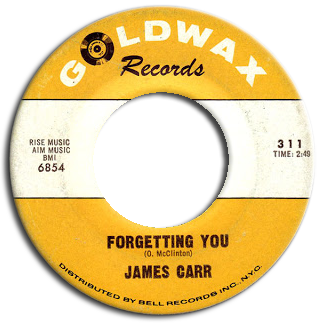 Back in 2007 I wrote something about an amazing James Carr B Side Forgetting You. "...the band (led by that incredible Reggie Young guitar) shifts things down to a minor key, then just builds and builds," I said. Years later, when I asked Reggie about it he said, "That's not me." Hmmmm... as we delved further into the Memphis guitar player thing with our Clarence Nelson investigation, I thought maybe we had our man. I asked Goldwax founder Quinton Claunch point-blank like ten times... "No, it wasn't Clarence. It was some other guy - Chips found him for me." Ugh.
Back in 2007 I wrote something about an amazing James Carr B Side Forgetting You. "...the band (led by that incredible Reggie Young guitar) shifts things down to a minor key, then just builds and builds," I said. Years later, when I asked Reggie about it he said, "That's not me." Hmmmm... as we delved further into the Memphis guitar player thing with our Clarence Nelson investigation, I thought maybe we had our man. I asked Goldwax founder Quinton Claunch point-blank like ten times... "No, it wasn't Clarence. It was some other guy - Chips found him for me." Ugh.
 The song had been written by the great O.B. McClinton, who was there on the ground floor with Quinton, both as an artist and songwriter, cutting this seminal B Side for Goldwax in 1964, She's Better Than You. In the liner notes to The Complete Goldwax Singles Volume 1 Quinton is quoted as saying, "He wrote that for James... I brought Steve Cropper to do guitar on that thing. He wasn't tied up exclusively at that time. I just employed him to play on that one track." Hmmm...
The song had been written by the great O.B. McClinton, who was there on the ground floor with Quinton, both as an artist and songwriter, cutting this seminal B Side for Goldwax in 1964, She's Better Than You. In the liner notes to The Complete Goldwax Singles Volume 1 Quinton is quoted as saying, "He wrote that for James... I brought Steve Cropper to do guitar on that thing. He wasn't tied up exclusively at that time. I just employed him to play on that one track." Hmmm...
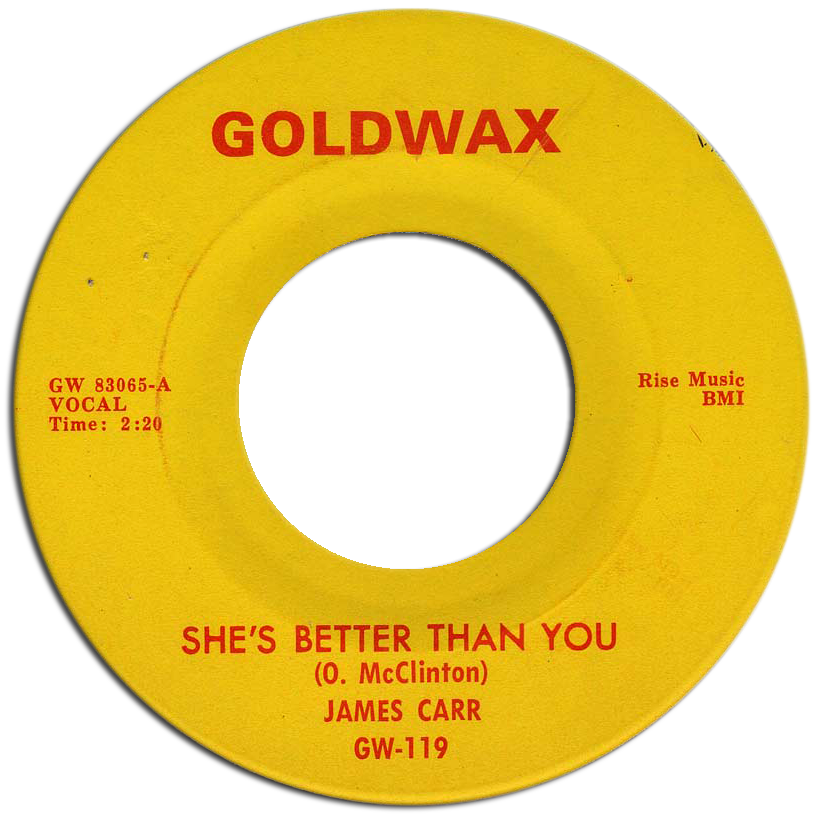
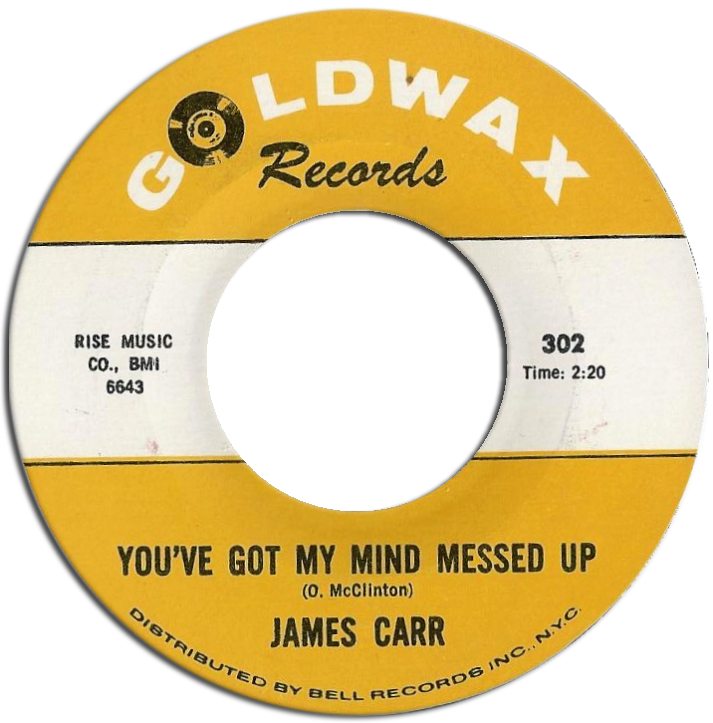 James would then take another song O.B. had written for him and break into the Billboard R&B top ten, taking You've Got My Mind Messed Up all the way to #7 for Goldwax in early 1966. The liner notes for The Complete Goldwax Singles Volume 2 mention "Reggie Young's distinctive opening guitar..." but it is quite obvious that whomever the guitar player is on here is the same as on the record that started all this in the first place, the flip of Carr's next release for the label, Forgetting You. If we are to believe Reggie's assertion that it's not him (and why wouldn't we?), then who on earth could it be?
James would then take another song O.B. had written for him and break into the Billboard R&B top ten, taking You've Got My Mind Messed Up all the way to #7 for Goldwax in early 1966. The liner notes for The Complete Goldwax Singles Volume 2 mention "Reggie Young's distinctive opening guitar..." but it is quite obvious that whomever the guitar player is on here is the same as on the record that started all this in the first place, the flip of Carr's next release for the label, Forgetting You. If we are to believe Reggie's assertion that it's not him (and why wouldn't we?), then who on earth could it be?
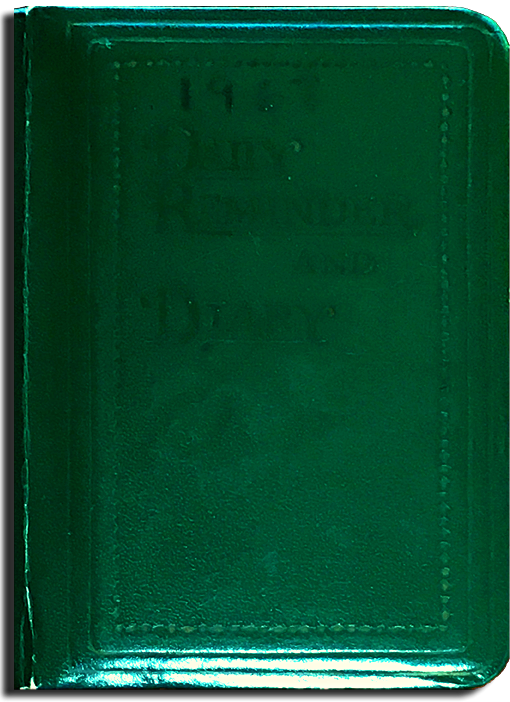 I've been working behind the scenes here deciphering the 1967 log book as part of our Reggie Young Discography Project with (besides the usual suspects) my friend Mark Nicholson, the proprietor of the excellent American Sound Archive on YouTube. As it turns out, he is also quite the Soul Detective...
I've been working behind the scenes here deciphering the 1967 log book as part of our Reggie Young Discography Project with (besides the usual suspects) my friend Mark Nicholson, the proprietor of the excellent American Sound Archive on YouTube. As it turns out, he is also quite the Soul Detective...
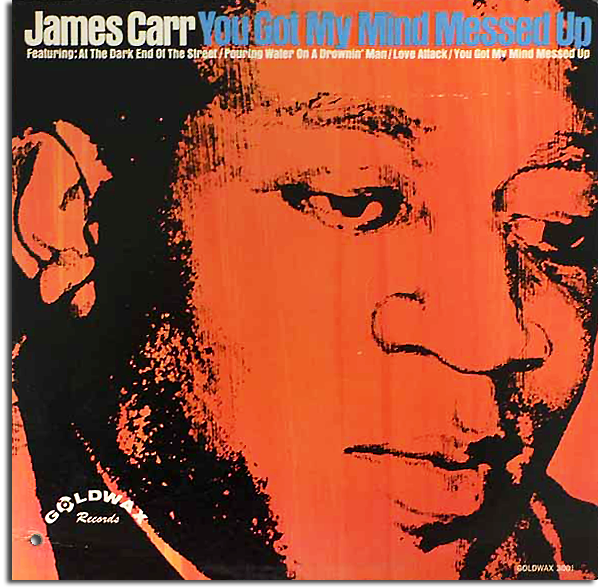 'Bloodhound' Nicholson recently pointed out this review of Carr's 1967 You've Got My Mind Messed Up LP by Thom Jurek, a 'Senior Staff Writer' at AllMusic, in which he states "By the album's end with the title track, listeners hear the totality of the force of Memphis soul. With Steve Cropper's guitar filling the space in the background, Carr offers a chilling portrait of what would happen to him in the future..."
'Bloodhound' Nicholson recently pointed out this review of Carr's 1967 You've Got My Mind Messed Up LP by Thom Jurek, a 'Senior Staff Writer' at AllMusic, in which he states "By the album's end with the title track, listeners hear the totality of the force of Memphis soul. With Steve Cropper's guitar filling the space in the background, Carr offers a chilling portrait of what would happen to him in the future..."
Wait, WHAT??? STEVE CROPPER???
 Hmmmm... Well, come to think of it, it does kind of sound like him, and we've already established that he was employed by Goldwax "to play on that one track..." Do you think it's possible that Quinton Claunch, that sly old fox, has been keeping Cropper's name out of it all these years because of his being 'tied up' at Stax when James cut these landmark recordings?
Hmmmm... Well, come to think of it, it does kind of sound like him, and we've already established that he was employed by Goldwax "to play on that one track..." Do you think it's possible that Quinton Claunch, that sly old fox, has been keeping Cropper's name out of it all these years because of his being 'tied up' at Stax when James cut these landmark recordings?
Now THAT would be something!!
UPDATE: MAY 2021Scott Ward asked Steve Cropper if that was him on 'Forgetting You' "Nope."
Rob Bowman asked Steve Cropper if that was him on 'You've Got My Mind Messed Up' "Nope."
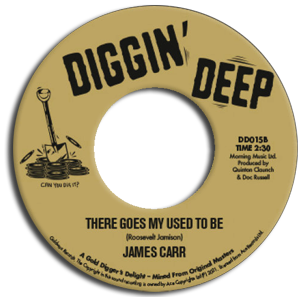 The crew at Diggin' Deep Records recently sent me a copy of their new James Carr release (bless their hearts), with two rare Goldwax era cuts new to 45. I Don't Want To Be Hurt Anymore is quintessential Reggie Young all the way. The flip on the other hand (which Quinton had left 'in the can' at the time) is Carr's smoldering take on Roosevelt Jamison's There Goes My Used To Be which, I believe, features our same mystery guitar player...
The crew at Diggin' Deep Records recently sent me a copy of their new James Carr release (bless their hearts), with two rare Goldwax era cuts new to 45. I Don't Want To Be Hurt Anymore is quintessential Reggie Young all the way. The flip on the other hand (which Quinton had left 'in the can' at the time) is Carr's smoldering take on Roosevelt Jamison's There Goes My Used To Be which, I believe, features our same mystery guitar player...
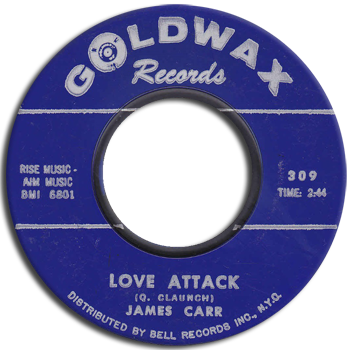 There is one more track that we hadn't mentioned yet that, without a doubt, has our mystery man on guitar - the awesome Quinton Claunch penned Love Attack, which would cruise to #21 R&B in the Summer of 1966.
There is one more track that we hadn't mentioned yet that, without a doubt, has our mystery man on guitar - the awesome Quinton Claunch penned Love Attack, which would cruise to #21 R&B in the Summer of 1966.
With Quinton Claunch now passed on, the quest to identify this great Memphis musician becomes even more compelling... detectives?
UPDATE: SEPTEMBER 2021While we were down in Muscle Shoals last month, we played the 'mystery guitarist' tracks for our man Travis Wammack, who was a Memphis guitar slinger himself in those days, working with Roland Janes at Sonic. "I don't know for sure," he said, "it could be Chips." Larry Rogers had said the same thing, as did Juke Blues founder Cilla Huggins... but I wasn't buying it. Why wouldn't Quinton have just said that, instead of saying it was 'a guy Chips found' for him? I don't know.
Then I realized there was one other Memphis guitar player from those days that I hadn't asked, Bobby Manuel. What he said kind of blew me away:
"I just had a wild thought. If it has that telecaster sound like Reggie or Cropper it possibly could have been the Bar-Kays first guitar player, Jimmy King. I know James Alexander founder of the Bar-Kays was friends with Chips. James took me to American to meet Chips, so I know there was a relationship there. Chips could have been made aware of Jimmy King, the next in line to take Cropper's place until he was killed with Otis in that terrible crash..."
WHOAH!!! Let's check it out...
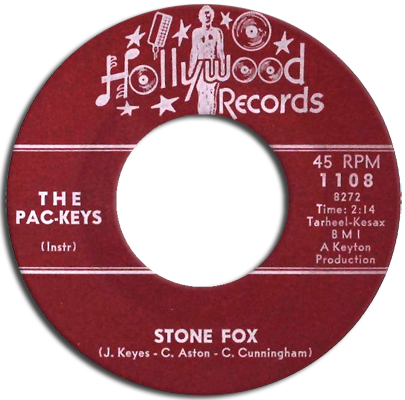 As far as I can tell, King's first appearance on record was with The Pac-Keys on Stone Fox. According to Rob Bowman, it was cut at Hi in mid 1966 as 'revenge' for Jim Stewart refusing to cut Packy Axton at Stax. The Bar-Kays themselves had been turned away at Stax' door by Steve Cropper, and were only too happy to help out, I'm sure. In addition to Jimmy, that's James Alexander on bass, and 'prodigy' Carl Cunningham on drums. The earliest of the James Carr 'mystery' tracks above (She's Better Than You) was cut in the latter half of '65, and the guitar sound is pretty close, I'd say. Chips Moman, of course, had his own axe to grind with Stax, and may have recommended King just to aggravate Cropper.
As far as I can tell, King's first appearance on record was with The Pac-Keys on Stone Fox. According to Rob Bowman, it was cut at Hi in mid 1966 as 'revenge' for Jim Stewart refusing to cut Packy Axton at Stax. The Bar-Kays themselves had been turned away at Stax' door by Steve Cropper, and were only too happy to help out, I'm sure. In addition to Jimmy, that's James Alexander on bass, and 'prodigy' Carl Cunningham on drums. The earliest of the James Carr 'mystery' tracks above (She's Better Than You) was cut in the latter half of '65, and the guitar sound is pretty close, I'd say. Chips Moman, of course, had his own axe to grind with Stax, and may have recommended King just to aggravate Cropper.
The remaining Carr sides mentioned above were all recorded prior to Moman cutting The Dark End Of The Street at Hi with Reggie Young in November of 1966.
 According to Bowman, it was Jim Stewart who suggested to The Bar-Kays that they come and audition at Stax when Cropper wasn't around. On March 13, 1967 they cut the song that would become an international phenomenon, Soul Finger in 'about fifteen minutes'. It would climb as high as #3 R&B (#17 Pop) that Summer of Love, before the B Side, Knucklehead (with Booker T. on harmonica!), began charting as well, going to #28 R&B on its own.
According to Bowman, it was Jim Stewart who suggested to The Bar-Kays that they come and audition at Stax when Cropper wasn't around. On March 13, 1967 they cut the song that would become an international phenomenon, Soul Finger in 'about fifteen minutes'. It would climb as high as #3 R&B (#17 Pop) that Summer of Love, before the B Side, Knucklehead (with Booker T. on harmonica!), began charting as well, going to #28 R&B on its own.
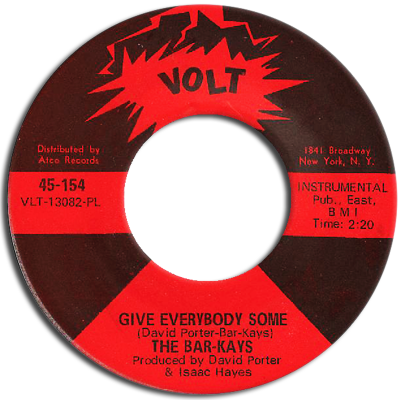 With Isaac Hayes and David Porter now assigned to produce them, The Bar-Kay's follow-up single, Give Everybody Some, would break into the R&B top 40 as well. Once you hear "alright, guitar, you got it," (at about 1:10) Jimmy King launches into a smoldering Memphis guitar solo that may be the best evidence yet that he is indeed our mystery man... but allow me to call your attention to exhibit B - this 'deep' track from the obligatory Lp Stax would release on them that Fall, With A Child's Heart. There's that slight distortion, that superb tone we hear on the Carr sides... I have to agree with Bobby, I think we have our man!
With Isaac Hayes and David Porter now assigned to produce them, The Bar-Kay's follow-up single, Give Everybody Some, would break into the R&B top 40 as well. Once you hear "alright, guitar, you got it," (at about 1:10) Jimmy King launches into a smoldering Memphis guitar solo that may be the best evidence yet that he is indeed our mystery man... but allow me to call your attention to exhibit B - this 'deep' track from the obligatory Lp Stax would release on them that Fall, With A Child's Heart. There's that slight distortion, that superb tone we hear on the Carr sides... I have to agree with Bobby, I think we have our man!
 Not more than a child himself, Jimmy King (in glasses above) was just 18 when he perished along with Otis Redding, Carl Cunningham and four others in the icy plane crash that tore the heart out of Memphis.
Not more than a child himself, Jimmy King (in glasses above) was just 18 when he perished along with Otis Redding, Carl Cunningham and four others in the icy plane crash that tore the heart out of Memphis.
May God Rest Their Souls.
Special thanks to Quinton Claunch, Bobby Manuel, Travis Wammack, Steve Cropper, Rob Bowman, Scott Ward, Larry Rogers, Cilla Huggins, Diggin' Deep Records, Thom Jurek, Mark Nicholson and John Broven. - red kelly, September 2021
Please let us know what you think about all of this, either on the Facebook Page, or by shooting us an email. Inquiring minds want to know!


_______________________________________

_______________________________________
 _______________________________________
_______________________________________















_______________________________________
 _______________________________________
_______________________________________ _______________________________________
_______________________________________


